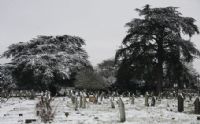

|
|
|
Bleak midwinter in the Cemetery Bleak midwinter in the Cemetery Date added: 02/01/2022 08:53:11 This month’s photo was taken in early 2021 showing nothing very much going on; everything looks peaceful, asleep, and perhaps even dead. However, winter is an important time in the life cycles for both animal and plant species to ensure their survival so they can multiply when spring returns. Some animals will go into hibernation which is a state of suspended animation when the body rate slows down and the need for food and oxygen is dramatically reduced. Some of the creatures will have prepared in advance by constructing a warm safe space and putting on extra fat to insulate them and sustain them during the hard times. Overwintering in the Cemetery, we could expect mammals, for example, squirrels, hedgehogs and bats and also snakes, snails and probably toads. Some adult insects will survive in nooks and crannies and some lay eggs which hatch at the time their favourite food sources become available. Bees, which play such an important role as pollinators, depend on the stores of honey they collected earlier in the year but interestingly, in the case of bumble bees, it is only the queens who are “entitled“ to feed so that they can produce the next generation. In plants, winter dormancy is a period when their metabolism comes to a virtual standstill to conserve their energy. This is caused by low temperatures slowing down chemical activity and the change in the wavelength of whatever light is available during the shorter days. Some plants have a biological clock which triggers the processes to enable the soft tissues to withstand freezing temperatures. Some evergreen coniferous species produce extra sugar-like substances in their needles which act like antifreeze and protect the cells against damage during extreme cold. Many plants ensure their future by producing seed. When a mature and viable seed does not germinate it is said to be dormant and some seeds actually require a period of freezing before they will germinate. In addition, there is activity and change occurring within the soil itself. Bacteria break down organic matter and the amazing network of mycorrhizal fungi plays an important part in plant nutrition, soil biology and soil chemistry. So in the short, dark days of winter, let us wait patiently and look forward to spring time remembering the words of Percy Bysshe Shelley, (from his Ode to the West Wind), “If Winter comes, can Spring be far behind?” Joan © FNRC
Images related to this news article |
Website designed and maintained by Paul Thompson on behalf of the Friends of Newtown Road Cemetery.

